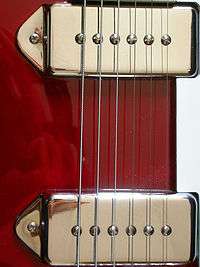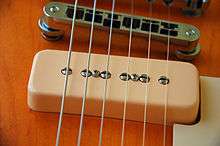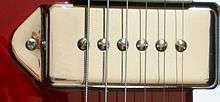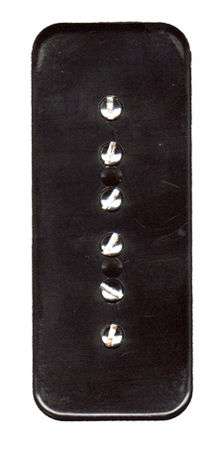P-90
| P-90 | |
|---|---|
 | |
| Manufacturer | Gibson |
| Period | 1946–1957, reissues since 1968 |
| Type | Passive single-coil |
| Magnet type | Alnico 3 (early), Alnico 5 (later) |
| Output specifications | |
| Voltage (RMS), V | 241.1 mV at 6.405 kHz resonant frequency |
| Impedance, kΩ | 7.47 kΩ at 6.405 kHz resonant frequency |
| Sonic qualities | |
| Resonant frequency, Hz | 6.405 kHz |
The P-90 is a single coil electric guitar pickup produced by Gibson since 1946. Gibson is still producing P-90s, and there are outside companies that manufacture replacement versions.
History
Around 1940 Gibson offered a new bridge pickup for ES-100/125 series, as an alternative to the classic Charlie Christian, cased in metal.
Officially P-90 pickups were introduced in 1946, when Gibson resumed guitar production after World War II. They were initially used to replace Gibson's original "bar" or "blade" pickup (also known by many as the "Charlie Christian pickup") on models such as the ES-150, and by the end of the 1940s it was the standard pickup on all models.
The P-90's reign as the Gibson standard pickup was short-lived, however, as a new design of pickup, the humbucker, was introduced in 1957. Equipped with double coils, the new pickup boasted greater output and less hum, although with less high end response. This new pickup, occasionally named PAF, very quickly took over as the preferred choice for all Gibson models, relegating the P-90 to budget models such as the ES-330, the Les Paul Junior and Special, and the SG Junior and Special, such as those used by Pete Townshend and Carlos Santana. This trend continued throughout the 1960s and particularly in the early 1970s, where the pickup all but disappeared from the entire Gibson range. By the 1970s, smaller single-coil pickups, mini-humbucking pickups, and uncovered humbucking pickups began replacing the P-90 pickups on Gibson's budget and lower-end models.
In 1968, however, Gibson re-issued the original, single-cutaway Les Paul - one version of which was a Goldtop with P-90 pickups. In 1972, they produced Limited Edition reissues - the "58 Reissue" - actually based on the '54 Goldtop Les Paul, with a stopbar tailpiece; and the '54 Custom, the Black Beauty, equipped with a P-90 in the bridge and an Alnico 5 pickup at the neck - the total production of these guitars was quite small. In 1974, Gibson put the P-90 pickup in their Les Paul '55, a reissue of the Les Paul Special from that era. It was followed in 1976 by the Les Paul Special Double-cutaway model and in 1978 by the Les Paul Pro (which had an Ebony fingerboard with trapezoid inlays). Since the 1970s the P-90 pickup has seen some success in various models in the Gibson line, mostly through reissues and custom versions of existing models. Currently it is featured most prominently on the Les Paul Faded Doublecut, and certain models in the "Historic" range.
In the early 1970s, Punk rock guitarists such as Johnny Thunders of The New York Dolls began using Les Paul Juniors and Les Paul Specials equipped with P-90's because of the cutting overdriven sound and the inexpensive nature of the guitars. In both The Dolls and The Heartbreakers, Thunders had a big influence on younger punk rock guitarists who adopted his look and choice of guitar. Mick Jones of The Clash and Steve Jones of The Sex Pistols both owned Les Paul Juniors, and the double cutaway Junior became the first choice for punk rock guitarists.
The P-90 was also marketed by Gibson in the 1970s as the "Laid Back" pickup, as part of a line of "named" pickups.[1]
For the 2014 model year, the new version of the Les Paul Melody Maker features a variant of the P-90 pickup called the "P-90S." This variant, inspired by the original pickup of the Gibson ES-125, possesses six Alnico slug pole pieces (similar to a Fender single-coil pickup) with no height adjustment for individual pole pieces.
Varieties
There are three major varieties of P-90 casing:

- Soap bar casing has true rectangular shape and the mounting screws are contained within the coil perimeter, positioned between the pole pieces, between the second and third strings and between the fourth and fifth strings, thus creating an irregular and somewhat unusual pattern. Occasionally they are mistaken for pole pieces, thus sometimes the P-90 is erroneously said to have eight pole pieces. The "soap bar" nickname most probably comes from its predominantly rectangular shape and proportions, and the fact, that the first P-90s on the original Gibson Les Paul Model of 1952 were white. A variant of the Soap-Bar P-90 is one, which uses the "dog ear" mounting plate, or frame, but the "soap bar" cover. The reason for the variation was to mount the pickup from a flat overlaying pickguard, such as is found on the Gibson SG Special (and other SG guitars using P-90's). The "dog ear" mounting plate is fitted with screws and springs, that attach it to the flat pickguard and allow the pickup to hang within the body rout. The soap bar cover is used, and the soap bar mounting screws are used to affix the cover to the dog ear plate.

- Dog ear is a casing type with extensions at both sides of pickup, that somewhat resemble dogs' ears. These are extensions of the predominantly rectangular cover, that encompass the outlying mounting screws. Dog-ear P-90 pickups were commonly mounted on Gibson's hollow body guitars like the ES-330 and occasionally on solid body models like the Les Paul Junior. The same pickups were also available on Epiphone models (since Gibson was building Epiphone guitars in the 1950s) and the design is best remembered for its appearance on the hollow body Epiphone Casino of the mid to late 1960s. All three Beatles guitarists bought one, and recently, Paul McCartney said, "If I had to choose one electric guitar, it would be this one."
- Humbucker Casing The Gibson designed P-90s come in a unique shape, wider than a Fender-style single coil but narrower than a humbucker, and longer than both. If one wanted to install a P-90 in a guitar routed for humbucker pickups (a Les Paul Standard for example), the existing rout in the body would have to be modified. This may result in aesthetic issues, due to gaps between the body and hardware, or even structural problems, as is the case, when re-routing the neck humbucker opening on a Gibson SG guitar. Because of this, "pseudo" P-90s in a humbucker-sized casing are common (see below).
Sound
Being a single-coil design, the tone of a P-90 is somewhat brighter and more transparent than a humbucker, though not quite as crisp and snappy as Fender's single-coil pickups. The tone therefore shares some of the single coil twang, but having large amounts of midrange and often described as brisk. The reason behind the tonal difference between P-90s and Fender single-coil pickups is due to construction methods. P-90s use bar magnets set under the polepieces, much like a humbucker, whereas Fender single-coils use rod magnets as the polepieces. Popular guitars that use or have the option of using P-90s are the Gibson SG, Gibson Les Paul, Ernie Ball Axis series and the Epiphone Casino. Fender Jazzmaster pickups are often confused with the P-90, however, their only similarity is cosmetic, since there are many significant visual, dimensional and electrical differences.
All Gibson P-90 pickups (vintage and otherwise) were machine wound on Leesona coil winding machines, although their electrical specifications may vary slightly due to operator error. In common with many other modern pickup types, there are two versions of modern P-90: neck and bridge version. Their DC resistance tends to be around 7-8 kΩ for neck pickups and 8-9 kΩ for bridge pickups. Early P-90 pickups made before approx. 1974 were manufactured with no difference in the bridge and neck position and were interchangeable. After winding, pickups were hung on a rack holding 20 pickups and assembled according to the model of guitar they were to be used on (Soap-Bar or Dog Ear). Earlier pickups (around 1952) had Alnico 3 magnets, but in 1957 Gibson switched to Alnico 5.
Hum-canceling and humbucker-shaped versions

One negative aspect of the P-90 pickup is its susceptibility to 50 Hz / 60 Hz mains hum induced in its coil by external electromagnetic fields originating in mains-powered electrical appliances, motors, lighting ballasts and transformers, etc. This susceptibility is common to all single-coil pickup designs, but the P-90, having around 2,000 more turns of wire in its coil than Fender pickups, produces a relatively large amount of mains hum. Several manufacturers now make hum-canceling pickups that resemble the P-90 but most do not have a similar sound.
There are three types of hum canceling pickups that look like a P-90:
• First generation Stacks (vertically stacked coils) such as Duncan and Gibson P-100 and H-90.
• Sidewinders (horizontal side-by-side coils) such as Lace and Fralin.
• New generation vertical humbuckers such as Kinman P-90 Hx (Patented).
First generation Stacks have a second identical coil placed below the main one; hum is effectively canceled by connecting both coils out of phase, however as with all common stacks there is a large degree of magnetic coupling between the coils and string signal is canceled along with the hum. Manufacturers over-wind the coils to recover the loss of output but this introduces a second problem of excessive coil capacitance which robs the sound of dynamics, presence and touch sensitivity. These two design flaws led to these types of pickups acquiring a bad reputation among musicians.
The Sidewinder is essentially a rearranged Stack and has the same sonically disastrous technical problems as Stacks. These type of pickups have the same appearance of P-90’s but are sonically far removed so are correctly known as look-alike P-90s.
The new generation Zero-Hum P-90 Hx by Kinman has an authentic P-90 sound and appearance but is far more complex with some 202 individual parts. Sonically destructive Magnetic coupling between the coils is negated by highly efficient magnetic shields around the upper coil. The lower coil is wound with much thicker wire and far fewer turns onto a unique laminated steel bobbin which imparts ultra high efficiency, thus the hum voltage is the same as the upper coil and cancels hum perfectly. Kinman advertize their P-90 Hx as having a sonically transparent 600-Ohm hum sensor which is remarkable considering the large amount of hum that P-90’s put out.
There is a fourth type of pickup under a P-90 cover, referred to as a large mini-humbucker. These, however, are not intended to mimic the sound of a P-90. Like all side-by-side humbuckers, they have lower hum levels. This configuration operates in the same way as a humbucker: both coils individually respond to string vibrations, but since the two coils have a reversed magnetic polarity, the signal from both coils is added, while the hum is effectively canceled. Consequently, these types of pickups sound more like a humbucker than a P-90.
Around 1970, Gibson replaced the P-90 on several models with a mini side-by-side humbucker now known as the mini-humbucker. This pickup was originally used on Epiphone models such as the Sheraton and with suitable mounting hardware became interchangeable with the P-90. In response to a resurgence of popularity of the P-90 Gibson issued the P-100, a stacked version (see above) of the P-90. Gibson also makes a new noiseless P-90 version called the H-90, which is found in Billie Joe Armstrong's Signature Les Paul Junior Guitar. The H-90 has two stacked coils and Gibson claims that it does not lose the characteristics of a P-90 although many players feel differently and perhaps that’s the reason it is not used widely on other guitars.
References
External links
- Gibson official website, includes mp3 clips of guitars using P-90 pickups.
- Electric guitar pickup analysis results, a massive load of data on various pickup models, obtained in UIUC Physics 498"Physics of Music" course.